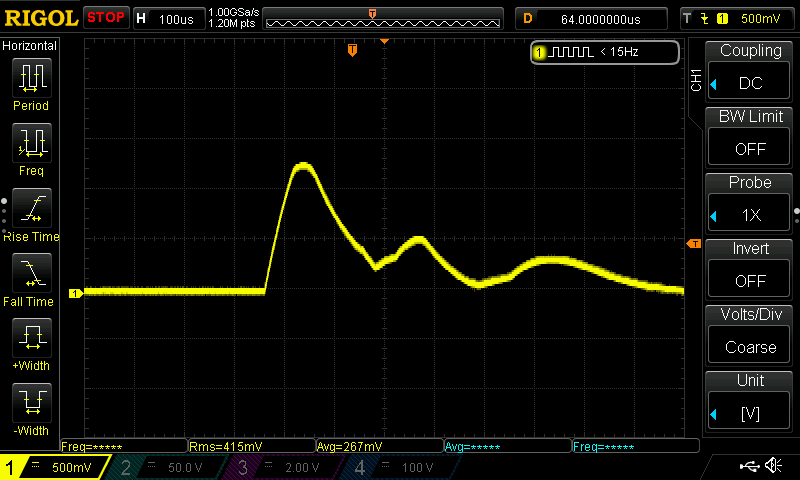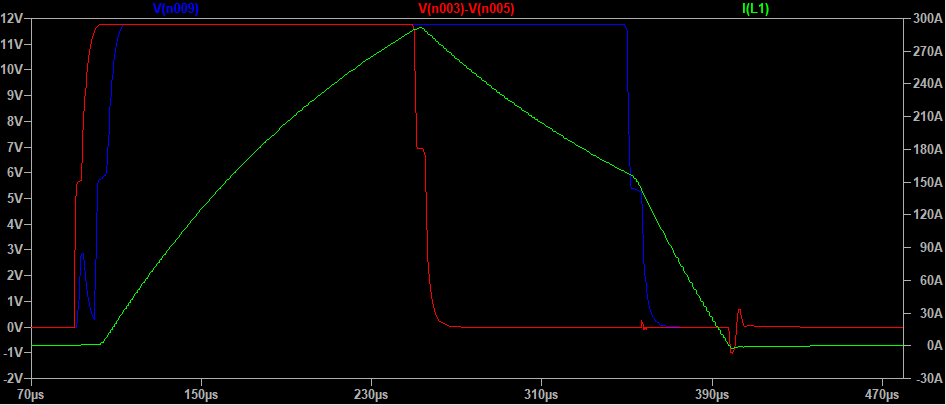This is a follow-up to a question I asked 3 years ago: My Coilgun Stage Driver Keeps Burning Out Mosfets. Any idea why?
I tried to take the advice in each of the answers and apply it to my circuit. But the MOSFETs still shoot through above approximately 260 V.
Here's my new test jig:
Closeup of the power component pack with labels:
 *note, this all sits directly on top of the mosfet packages.
*note, this all sits directly on top of the mosfet packages.
Schematic:
Firing sequence on MCU:
HIGHFET_SetHigh();
__delay_us(10); //give high side time to turn fully on
LOWFET_SetHigh(); //turn on low side: fire
__delay_us(150); //fire time
HIGHFET_SetLow(); //turn off high side, go into freewheeling
__delay_us(100); //freewheel time
LOWFET_SetLow(); //turn off low side, go into regeneration
Improvements:
Shortened the wires to the cap bank as much as possible to reduce the inductance.
Clumped all the power components together and used very short point to point wiring to minimize parasitic inductance.
Added 10 ohm gate drive resistors to slow the switching.
Added 0.1 uF caps to the mosfet gates to dilute parasitic effects (also slows switching)
Added a snubber to the coil.
Added TVS diodes everywhere.
Added tons of protection around the MCU to avoid spurious resets.
Switched to isolated gate drivers, instead of non-isolated + optocoupler on the high side (simpler, less to troubleshoot).
Oscilloscope Traces:
Low side gate while firing at 100 V:

Current transformer, firing at 180 V:

Current transformer, firing at 260 V burned out FETs:

Current waveform from LTSpice:

Datasheets:
MOSFETs FCH041N60F
Power diodes C6D10065E
Gate drivers MAX22702E
Addressing failure mode theories from my previous question:
Very fast current reversal in leads to cap bank may have lead to inductive voltage spike. [Added caps right at MOSFETs, slowed down switching, added TVS diodes]
Out of control ringing (not sure why that would cause a failure, but still not good). [Added a snubber to the coil. Sim showed this making a huge difference]
Core saturation leads to extremely high current. [checked with current transformer, no current spike.]
d(Vds)/dt exceeds mosfet rating and burns it out due to parasitic current paths. [Simulation shows ~90 V/us MOSFET rated for 100 V/ns]
Counterfeit parts. [Now using all parts from Digikey, no more ebay MOSFETs]
Coil capacitance leads to very brief high current spike. [Not visible on scope. Sim doesn't show any issue with a capacitance of 10 pF]
Summary:
I'm running out of ideas for what's causing the failure. My current best guess is some kind of high frequency resonance due to parasitics? That huge spike on the mosfet gate when switching to freewheeling seems like something, but I could just be noise? There is a 12 V TVS as close as it could possibly be to the gate and source.
Any theories would be appreciated. I'll test them if I can and report back.




